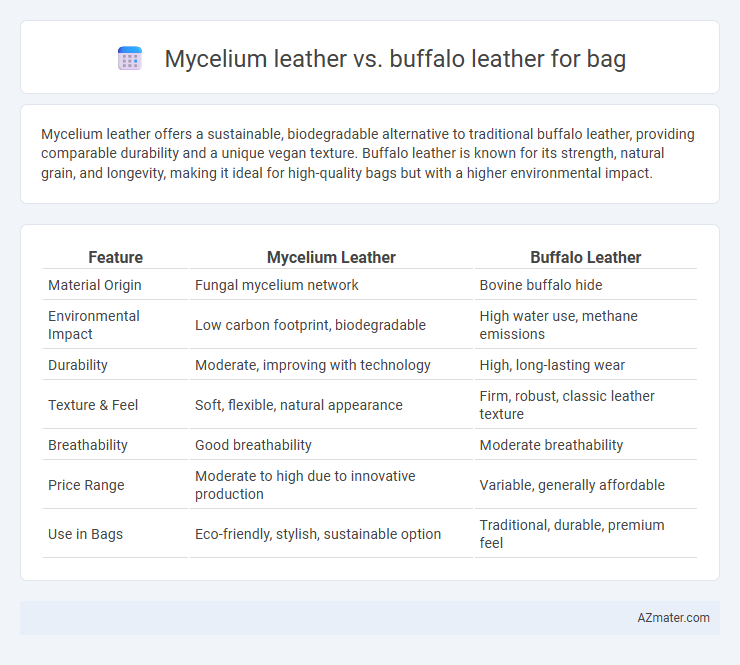Mycelium leather offers a sustainable, biodegradable alternative to traditional buffalo leather, providing comparable durability and a unique vegan texture. Buffalo leather is known for its strength, natural grain, and longevity, making it ideal for high-quality bags but with a higher environmental impact.
Table of Comparison
| Feature | Mycelium Leather | Buffalo Leather |
|---|---|---|
| Material Origin | Fungal mycelium network | Bovine buffalo hide |
| Environmental Impact | Low carbon footprint, biodegradable | High water use, methane emissions |
| Durability | Moderate, improving with technology | High, long-lasting wear |
| Texture & Feel | Soft, flexible, natural appearance | Firm, robust, classic leather texture |
| Breathability | Good breathability | Moderate breathability |
| Price Range | Moderate to high due to innovative production | Variable, generally affordable |
| Use in Bags | Eco-friendly, stylish, sustainable option | Traditional, durable, premium feel |
Introduction to Mycelium and Buffalo Leather
Mycelium leather, derived from mushroom root fibers, offers an eco-friendly and sustainable alternative to traditional animal-based materials. Buffalo leather, sourced from water buffalo hides, is renowned for its durability, natural grain, and luxurious texture commonly used in premium bags. Both materials present unique qualities--mycelium leather excels in biodegradability and ethical production, while buffalo leather delivers strength and classic aesthetic appeal.
What is Mycelium Leather?
Mycelium leather is an innovative, sustainable material derived from the root structure of fungi, offering a biodegradable alternative to traditional animal hides. Unlike buffalo leather, which is made from animal skins and involves resource-intensive processes, mycelium leather has a significantly lower carbon footprint and requires less water and land to produce. Its natural durability and flexibility make mycelium leather an emerging choice for eco-conscious bag manufacturers seeking cruelty-free and environmentally friendly options.
What is Buffalo Leather?
Buffalo leather is a durable, full-grain leather derived from the hide of water buffaloes, known for its toughness, natural grain, and resistance to wear and moisture. It offers a rugged texture and aging process that yields a unique patina, making it ideal for sturdy bags requiring long-lasting quality. Compared to mycelium leather, buffalo leather is a traditional animal-based material prized for its strength and classic look.
Durability Comparison: Mycelium vs Buffalo Leather
Mycelium leather exhibits impressive durability with resistance to scratches and flexibility due to its natural fibrous structure, while buffalo leather is renowned for its toughness and ability to withstand heavy wear and tear. Buffalo leather tends to develop a rich patina over time, enhancing its durability and aesthetic appeal, whereas mycelium leather maintains consistent performance without significant aging effects. In terms of long-term use, buffalo leather generally offers superior resilience in rugged conditions, but mycelium leather provides a sustainable and durable alternative suitable for everyday bags.
Sustainability and Environmental Impact
Mycelium leather, derived from mushroom roots, offers a highly sustainable alternative to buffalo leather due to its rapid growth cycle and minimal resource requirements, significantly reducing water usage and carbon emissions. Buffalo leather production involves intensive livestock farming that contributes to deforestation, methane emissions, and heavy water consumption, amplifying its environmental footprint. Choosing mycelium leather bags supports circular economy principles and biodiversity preservation, positioning it as a forward-thinking choice for eco-conscious consumers.
Aesthetic and Texture Differences
Mycelium leather offers a unique, sustainable aesthetic with a smooth, slightly fibrous texture that mimics natural leather's grain while exhibiting subtle, organic patterns. Buffalo leather boasts a rugged, durable surface characterized by deep grain textures and a more robust, tactile feel ideal for a traditional, vintage look. The contrast lies in Mycelium's modern, eco-friendly appearance versus Buffalo leather's classic, heavy-duty texture that ages with a distinctive patina.
Manufacturing Processes
Mycelium leather is produced through a sustainable process where fungal mycelium is cultivated and grown into sheets, offering a low-impact alternative with minimal chemical treatments. Buffalo leather undergoes a traditional tanning process involving animal hide curing, chemical soaking, and extensive drying, which can generate significant environmental waste. The manufacturing of mycelium leather reduces water usage and carbon emissions compared to buffalo leather, making it a more eco-friendly choice for bag production.
Cost Analysis: Mycelium vs Buffalo Leather
Mycelium leather offers a cost-effective alternative to buffalo leather by utilizing fast-growing fungal biomass that reduces raw material expenses, making it more affordable for sustainable bag production. Buffalo leather, derived from large mammals, involves higher costs due to animal rearing, processing, and environmental impact fees. Brands seeking budget-friendly eco-friendly options benefit from Mycelium leather's lower manufacturing costs and scalable production compared to traditional buffalo leather bags.
Ethical Considerations for Bag Choices
Mycelium leather offers a sustainable and cruelty-free alternative to traditional buffalo leather, significantly reducing environmental impact and deforestation associated with livestock farming. Its production involves low energy consumption and minimal water use, making it an ethical choice for eco-conscious consumers seeking animal-friendly materials. Choosing mycelium leather bags supports innovative, biodegradable design solutions that align with ethical fashion values.
Which Leather is Right for Your Bag?
Mycelium leather offers a sustainable and eco-friendly alternative to traditional buffalo leather, boasting durability and a unique texture perfect for innovative bag designs. Buffalo leather remains renowned for its toughness, natural grain, and luxurious aging, making it ideal for classic, long-lasting bags that withstand heavy use. Choosing between mycelium and buffalo leather depends on your priorities: sustainability and modern aesthetics favor mycelium, while timeless durability and rugged elegance prioritize buffalo leather.

Infographic: Mycelium leather vs Buffalo leather for Bag
 azmater.com
azmater.com